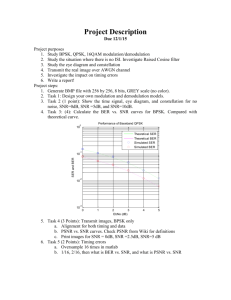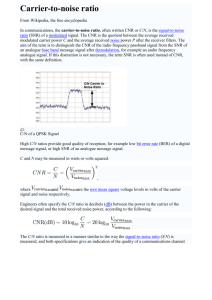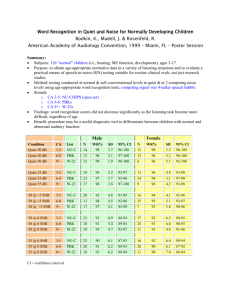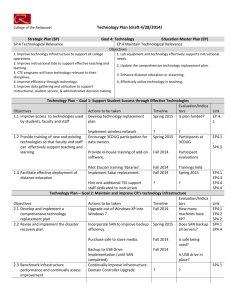Optimal Diversity-Multiplexing Tradeoff in Multiple Antenna Channels
advertisement
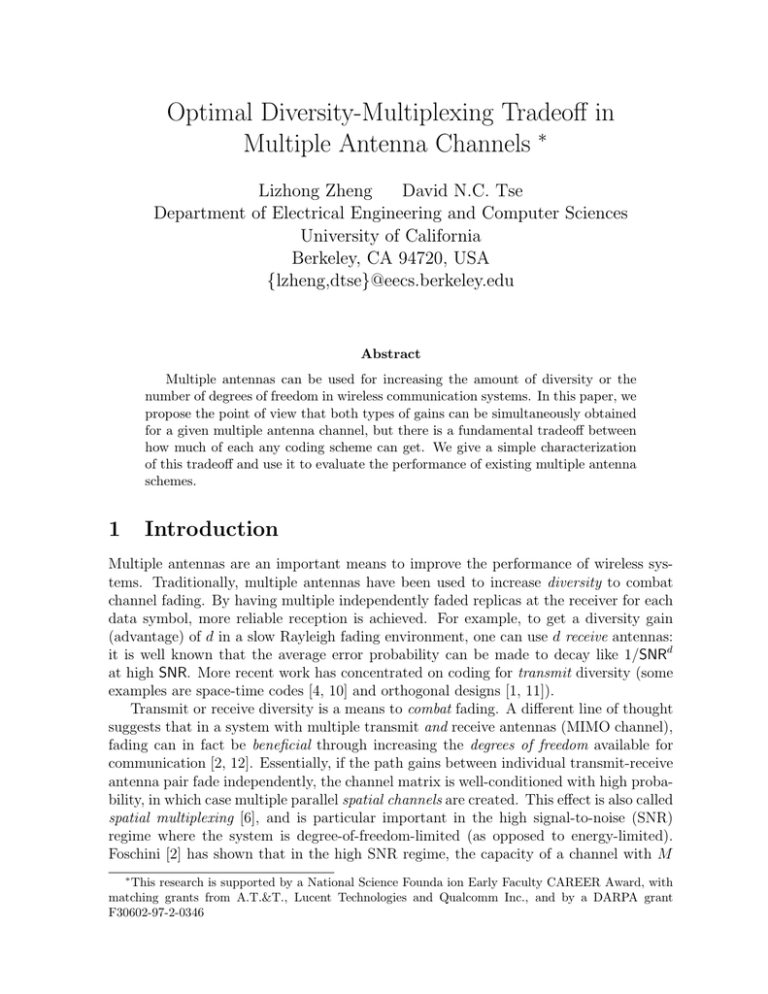
Optimal Diversity-Multiplexing Tradeoff in
Multiple Antenna Channels ∗
Lizhong Zheng
David N.C. Tse
Department of Electrical Engineering and Computer Sciences
University of California
Berkeley, CA 94720, USA
{lzheng,dtse}@eecs.berkeley.edu
Abstract
Multiple antennas can be used for increasing the amount of diversity or the
number of degrees of freedom in wireless communication systems. In this paper, we
propose the point of view that both types of gains can be simultaneously obtained
for a given multiple antenna channel, but there is a fundamental tradeoff between
how much of each any coding scheme can get. We give a simple characterization
of this tradeoff and use it to evaluate the performance of existing multiple antenna
schemes.
1
Introduction
Multiple antennas are an important means to improve the performance of wireless systems. Traditionally, multiple antennas have been used to increase diversity to combat
channel fading. By having multiple independently faded replicas at the receiver for each
data symbol, more reliable reception is achieved. For example, to get a diversity gain
(advantage) of d in a slow Rayleigh fading environment, one can use d receive antennas:
it is well known that the average error probability can be made to decay like 1/SNRd
at high SNR. More recent work has concentrated on coding for transmit diversity (some
examples are space-time codes [4, 10] and orthogonal designs [1, 11]).
Transmit or receive diversity is a means to combat fading. A different line of thought
suggests that in a system with multiple transmit and receive antennas (MIMO channel),
fading can in fact be beneficial through increasing the degrees of freedom available for
communication [2, 12]. Essentially, if the path gains between individual transmit-receive
antenna pair fade independently, the channel matrix is well-conditioned with high probability, in which case multiple parallel spatial channels are created. This effect is also called
spatial multiplexing [6], and is particular important in the high signal-to-noise (SNR)
regime where the system is degree-of-freedom-limited (as opposed to energy-limited).
Foschini [2] has shown that in the high SNR regime, the capacity of a channel with M
∗
This research is supported by a National Science Founda ion Early Faculty CAREER Award, with
matching grants from A.T.&T., Lucent Technologies and Qualcomm Inc., and by a DARPA grant
F30602-97-2-0346
transmit, N receive antennas and i.i.d. Rayleigh faded gains between each pair is given
by:
C(SNR) = min{M, N } log SNR + O(1).
The number of degrees of freedom is thus the minimum of M and N . In recent years,
several schemes have been proposed to exploit this spatial multiplexing phenomenon (for
example BLAST [2]).
Most of current research focus on designing schemes to extract maximal diversity
gain or maximal spatial multiplexing gain. In this paper, we put forth a new viewpoint:
given a MIMO channel, both gains can in fact be simultaneously obtained, but there
is a fundamental tradeoff between how much of each type of gain any coding scheme
can extract. We give a simple characterization of the tradeoff curve and use it as a
unified framework to evaluate the performance of many existing diversity-based and
multiplexing-based schemes.
To be more specific, we focus on the high SNR regime, and think of a scheme as a
family of codes, one for each SNR level. A scheme is said to have a spatial multiplexing
gain r and a diversity advantage d if the rate of the scheme scales like r log SNR and
the average error probability decays like 1/SNRd . The tradeoff curve yields for each
multiplexing gain r the optimal diversity advantage d∗ (r) achievable by any scheme.
Clearly, r cannot exceed the number of degrees of freedom in the channel and d(r)
cannot exceed the maximal diversity gain. For several well-known schemes, we compute
the curves d(r) and compare it to the optimal tradeoff curve.
The rest of the paper is outlined as follows. Section 2 presents the system model and
the precise problem formulation. Our main result on the optimal diversity-multiplexing
tradeoff curve is presented in Section 3. We establish a connection between our formulation with the outage capacity formulation in Section 4 and with the theory of error
exponents in Section 5. We compare the performance of several schemes with this optimal tradeoff curve in Section 6. Section 7 contains the conclusions. The proofs of all the
results presented here can be found in the journal version of the paper.
2
System Model and Problem Formulation
We consider the wireless link with M transmit and N receive antennas. The fading
coefficient hij is the path gain from transmit antenna j to receive antenna i. We assume
that the coefficients are independently Rayleigh distributed with unit variance, and write
H = [hij ] ∈ C N ×M . H is assumed to be known to the receiver, but not at the transmitter.
We focus on a single block of T symbols, within which the channel is assumed to remain
constant. Within this block, the channel can be written as:
r
SNR
Y=
HX + W
(1)
M
where X ∈ C M ×T has entries xmt , m = 1, . . . , M, t = 1, . . . , T being the signals transmitted from antenna m at time t; Y ∈ C N ×T has entries ynt , n = 1, . . . , N, t = 1, . . . , T being
the signals received from antenna n at time t; the additive noise W has i.i.d. entries
wnt ∼ CN (0, 1); SNR is the average signal to noise ratio at each receive antenna.
The transmitted signal X is normalized to have the average transmitted power at
each antenna in each symbol period to be 1. The power constraint on a codebook C can
be written as
M
T
1 XXX
kxmt (i)k2 ≤ M T,
|C| i m=1 t=1
where the first sum is over all the codewords in the codebook. We now consider a family
of codes {C(SNR)} of block length T , one at each SNR level, and define its spatial multiplexing gain and diversity advantage in the high SNR regime. Let R(SNR) bits/symbol
and pe (SNR) be the rate and average error probability of the code C(SNR) respectively.
Definition 1 A scheme {C(SNR)} is said to achieve spatial multiplexing gain r and
diversity advantage d if as SNR → ∞, the data rates
R(SNR)/ log SNR → r
and average error probability
lim sup
SNR→∞
log pe (SNR)
= −d
log SNR
(2)
For each r, define d∗ (r) to be the supremum of the diversity advantage achieved by any
scheme.
For brevity, we will use the notation
.
pe (SNR) = 1/SNRd
to denote
log pe (SNR)
= −d
SNR→∞
log SNR
lim
The error probability pe (SNR) is averaged over the additive noise W, the channel
matrix H and the transmitted codewords (assumed equally likely). The definition of
diversity advantage here differs from the standard definition in the space-time code literature (see for example [10]) in two important ways:
• This is the actual error probability of a code, and not the pairwise error probability
between two codewords as is commonly used as a diversity criterion in space-time
code design.
• In the standard formulation, the code rate is fixed and the diversity gain describes
how fast the error probability decays with increasing SNR. Here, the code rate
also increases with SNR simultaneously. This is natural if one thinks of spatial
multiplexing as achieving a nonvanishing fraction of the degrees of freedom in the
channel. According to this definition, any fixed-rate scheme has a zero multiplexing
gain.
3
Main Result
The main result of this paper is an exact characterization of the optimal tradeoff d∗ (r)
for the case when the block length T ≥ M + N − 1.
Theorem 2 Assume T ≥ M + N − 1. Let K = min{M, N }. The optimal tradeoff d∗ (r)
is given by the piecewise linear function connecting the points (K − k, d∗ (K − k)), k =
0, . . . , K, where
d∗ (K − k) = k 2 + k|M − N |
(3)
Moreover, for each r, there exists a scheme {C(SNR)} with spatial multiplexing gain r
and
log pe (SNR)
= −d∗ (r),
SNR→∞
log SNR
lim
i.e. the limit defined in (2) actually exists.
Optimal Tradeoff, T>=M+N−1
Diversity Advantage d*(r)
(0,MN)
2
(1, (K−1) + (K−1)|M−N|)
.
.
.
2
(k, (K−k) +(K−k) |M−N|)
. .
.
(K−1, 1+|M−N|)
(K,0)
Spatial Multiplexing Gain r=R/log SNR (per symbol period)
Figure 1: Diversity-multiplexing tradeoff, d∗ (r) for general M, N and T ≥ M + N − 1.
The function d∗ (r) is plotted in Figure 1. The curve intersects the r axis at K =
min{M, N }, which is the number of degrees of freedom in the channel. This is the
maximal spatial multiplexing gain that can be obtained, but at this point there is no
diversity advantage. Increasing the diversity advantage comes at a price of decrease in
spatial multiplexing gain. The maximum diversity gain is M N , achievable by a fixed-rate
scheme (i.e. zero multiplexing gain). This is also the number of random channel gains
in the channel, and can be interpreted as the maximum number of independent random
variables that a diversity scheme can average over.
The tradeoff curve for the special case M = N is shown in Figure 2. In this case,
the maximum diversity gain for a given multiplexing gain k (k integer) is simply given
by (N − k)2 . Put it another way, to achieve a given diversity advantage of d (d perfect
Optimal Tradeoff, M=N, T>= 2N−1
2
Diversity Advantage d*(r)
(0,N )
2
(1, (N−1) )
.
..
(k, (N−k)2)
. .
.
(N−1, 1)
(N,0)
Spatial Multiplexing Gain r=R/log SNR (per symbol period)
Figure 2: Diversity-multiplexing tradeoff for M = N and T ≥ 2N − 1.
√
square), the maximum spatial multiplexing gain achievable is N − d. Since N is the
total number of available degrees of freedom in the channel, this reveals exactly the price
one must have to pay to achieve the desired level of diversity.
This result concerns the performance on transmission of a single block of length T .
One can prove an analogous result for the case when one codes over L such blocks,
each of which fades independently. This would model the case when antenna diversity
is combined with other forms of diversity, such as over time or frequency. Consider now
such schemes with rate scaling as r log SNR bits/symbol and error probability decaying
as 1/SNRdL (r) .
Theorem 3 For schemes which code over L i.i.d. faded blocks, each of length T ≥
M + N − 1, the optimal diversity advantage d∗L (r) for a given multiplexing gain of r is
given by d∗L (r) = Ld∗ (r) where d∗ (r) is given by Theorem 2.
This means that the diversity gain simply adds across the L blocks.
4
Connection to Outage Capacity Formulation
There is an interesting and insightful connection between Theorem 2 and the outage
capacity formulation, proposed in [7] for fading channels and applied to multi-antenna
channels in [12]. This formulation is used to analyze non-ergodic situations where the
fading channel, although random, remains fixed for all time (modeling the slow fading
scenario). Following [12], for a given target data rate R, the outage probability
¶
¸
·
µ
SNR
†
HQH < R
pout (R) =
inf
P logdet I +
Q≥0,tr(Q)≤M
M
is the probability that the mutual information per symbol falls below the target rate R,
under the minimizing input distribution. Here, the probability is taken over the random
channel H. Note that without loss of generality the input distribution can be taken
to be Gaussian, and the minimization is over the covariance matrix of the Gaussian
distribution.
We have the following asymptotic result on the outage probability at high SNR.
Theorem 4 If the target rate is scaled to be R = r log SNR, then
.
pout (r log SNR) = SNR−d
∗ (r)
,
where d∗ (r) is precisely the same function as defined in Theorem 2. Moreover Q∗ = I is
an asymptotically optimal input distribution at high SNR.
The proof of this result involves an analysis based on the distribution of the random
eigenvalues of HH† .
Theorem 4 provides a context for interpreting Theorem 2. If one believes that the
outage formulation captures the performance under infinite coding block length, what
Theorem 2 says is that as long as the block length T ≥ M +N −1, the infinite block length
performance is already achieved. This is because the tradeoff curve given in Theorem 2
actually does not depend on T as long as T ≥ M + N − 1. Thus, one cannot get more
diversity gain by coding over a longer block length than M + N − 1.
To prove Theorem 2, we show that the channel outage event is the dominant error
event. We show that there exists codes which yield good performance (i.e. error probability much smaller than the outage probability) whenever the channel is not in outage.
To prove this, we use a random coding argument.
The condition that the block length T ≥ M + N − 1 is not a technical one;if T <
M + N − 1, there are examples in which the outage performance cannot be achieved.
The results for this case are more involved and can be found in the journal version of the
paper.
5
Connection to Error Exponents
This is also an intimate connection of our results to the theory of error exponents (see
for example [3]). Consider now codes over a single block of length T symbols and have
rate R bits/symbol. We can think of these T symbols as one super-symbol. Applying
the theory of error exponents to a block of length one such supersymbol, it says that
the average error probability of the optimal code is upper bounded by 2−E(R) , where the
random coding exponent E(R)) is given by:
E(R) = max [E0 (ρ) − ρRT ],
0≤ρ≤1
and E0 (ρ) is given by
"Z ·Z
E0 (ρ) = sup − log EH
qX
¸1+ρ
qX (X)p(Y |X, H)1/(1+ρ) dX
#
dY ,
and the supremum is over all input distributions qX on the N by T matrix X. (The
calculation of this follows almost directly from [3]; see also [12] which did a similar
calculation for the case when T = 1.)
The following theorem connects the optimal tradeoff curve calculated in Theorem 2
and the random coding error exponent.
Theorem 5 Suppose T ≥ M + N − 1. If the rate R scales as r log SNR bits/symbol, then
for any r ≥ 0,
lim E(r log SNR)/ log SNR = d∗ (r),
SNR→∞
∗
where d (r) is given in Theorem 2. Moreover the i.i.d. Gaussian input distrbution qX is
asymptotically optimal in achieving the error exponent at high SNR.
This theorem says that the tradeoff curve of r versus d∗ (r) is actually a scaled version
of the plot R versus the error exponent E(R), with both axes scaled by 1/ log SNR. The
optimality of d∗ (r) implies that the random coding exponent not only yields an upper
bound to the error probability, but is actually tight under the high SNR scaling considered.
Several comments are in order:
• For finite SNR level, the optimal input distribution is not Gaussian, but should be
concentrated on a spherical shell [3]. Our result however says that at the high SNR
limit, Gaussian distribution does asymptotically as well.
• The tightness of the random coding error exponent is usually discussed in the regime
of long block lengths. Here, we are actually fixing the block length to be one supersymbol, but taking the high SNR limit. The tightness is in that regime.
• Even in the regime of long block lengths, the random coding exponent is in general
not tight for all rates, but only rates above a critical rate Rcrit . Our result says
however that for T ≥ M + N − 1, the random coding error exponent is tight for all
multiplexing gain r (albeit in a differnt asymptotic regime.) It is interesting that ,
for T ≥ M + N − 1, it can in fact be shown that Rcrit / log SNR approaches 0.
Another common upper bound for the average error probability of a random ensemble
of codes is the union bound. The union bound is simply the number of codewords times
the average error probability between a pair of random codewords. Under exactly the
same scaling considered for the random coding exponent in Theorem 5, the exponent
associated with the union bound also approaches a limit, as plotted in Figure 5. Under
the assumption that T > M + N − 1, we observe that compared to the optimal bound
d∗ (r), the union bound is quite loose except for r = 0. This strongly suggests that to get
significant multiplexing gain, a code design criterion based on pairwise error probability
is not adequate. In fact, it can be shown that for the codes achieving the optimal
curve d∗ (r), the typical error event is due to confusion with one of many codewords far
away from the transmitted codeword, rather than confusion with one of the few nearest
neighbors.
6
Evaluation of Existing Schemes
The diversity-multiplexing tradeoff can be used to evaluate and compare performance of
many existing schemes. We only discuss a few representative examples here.
We first consider the Alamouti scheme [1] (also called orthogonal design [11]) for
M = 2 transmit antennas. In this scheme, two symbols x1 , x2 are transmitted over two
symbol periods through the channel as follows:
r
¸
·
SNR
x1 x2
+W
H
Y=
−x∗2 x∗1
2
In our framework, we view Alamouti scheme as an inner code to be used in conjunction
with an outer code which generates the symbols xi ’s. The rate of the overall code scales
Optimal Tradeoff
Union Bound
Diversity Advantage d
slope=M+N−1
slope=T
Spatial Multiplexing Gain r=R/log SNR (per symbol period)
Figure 3: Comparison to Union Bound
as R = r log SNR. The tradeoff curve for Alamouti scheme can be computed for the best
outer code (or, more precisely, best family of outer codes). This is shown in Fig. 4 for
two cases: N = 1 receive antenna and N = 2 receive antennas. For the case of N = 1 and
T ≥ 2 (T even), Alamouti scheme is optimal, in the sense that it achieves the tradeoff
curve d( r) for all r. For the case of N = 2 and T ≥ 4, Alamouti scheme is sub-optimal: it
achieves the maximum diversity gain of 2 but at all other points its tradeoff curve d(r) is
strictly below the optimal tradeoff curve d∗ (r). The fact that Alamouti scheme does not
achieve the full degrees of freedom have already been pointed out [5]; this corresponds
in our framework to the fact that d(1) = 0. Our results give a stronger conclusion here:
the diversity-multiplexing tradeoff is strictly sub-optimal for all r other than r = 0.
Next we look at the BLAST schemes. We focus on one variant, D-BLAST [2]. We
plot the performance for two versions of this scheme in Fig. 5, for the case when the
block length T = ∞. and M = N . The version originally proposed in [2] is based on
nulling out the uncancelled layers and the tradeoff curve is the lower curve, which is
strictly sub-optimal. If we replace the nulling step by a linear MMSE receiver, on the
other hand, we get the upper curve, which is precisely the optimal tradeoff curve d∗ (r).
Thus, for infinite block length, MMSE D-BLAST is optimal , but Nulling D-BLAST is
not. This conclusion is quite surprising, since in the high SNR regime, one would expect
the MMSE receiver and the decorrelator (nuller) to have similar performance. The reason
is somewhat subtle and is explained in the full paper.
For the case when the block length T < ∞, MMSE D-BLAST is strictly sub-optimal
due to the loss in degrees of freedom in the first few symbols for the initialization of
the procedure. As the block length T becomes large, this loss is amortized and becomes
negligible for long block lengths.
Another variant of BLAST, V-BLAST, turns out to have a totally different tradeoff
curve. Its analysis is more intricate and will be presented in the full paper.
M=2, N=1, T=2
M=N=2, T=4
Diversity Advantage d
Optimal
Ortho−Designs
4
4
2
2
(1,1)
0
0
0.5
1
1.5
r=R/log(SNR)
2
2.5
0
0
0.5
1
1.5
r=R/log(SNR)
2
2.5
Figure 4: Diversity-multiplexing tradeoff for Alamouti scheme, N = 1 and N = 2.
7
Conclusions
Previous research on multi-antenna coding schemes has focused either on extracting
maximum diversity gain or maximum spatial multiplexing gain from the channel. In
this paper, we present a framework in which both diversity and spatial multiplexing gain
have equal footing in the picture. We characterize the fundamental tradeoff between the
two types of gains that can be extracted from a given MIMO channel. This framework
is useful for evaluating and comparing existing schemes as well as providing insights for
designing new schemes.
References
[1] S. Alamouti,” A simple transmitter diversity scheme for wireless communications”,
IEEE JSAC, Oct 1998, pp. 1451-1458.
[2] G.J.Foschini, “Layered space-time architecture for wireless communication in a fading environment when using multi-element antennas,” Bell Labs Technical Journal,
vol. 1, no. 2, pp. 41–59, 1996.
[3] R.G. Gallager, Information Theory and Reliable Communication, Wiley, 1968.
[4] J-C Guey et al., “Signal Designs for transmitter diversity wireless communication
system over Rayleigh fading channels”, Proc. VTC’96, pp. 136-140.
[5] B. Hassibi and H. Hochwald, “High-Rate Codes that are Linear in Space and Time”,
submitted to IEEE Trans. on Information Theory, August 2000.
D−BLAST Tradeoff, M=N
Optimal Tradeoff: MMSE
Nulling
2
Diversity Advantage d
(0,N )
2
(1, (N−1) )
(N−2,4)
(N−1,1)
(1, N(N−1)/2)
(N,0)
(0,N(N+1)/2)
(N−2,3)
Spatial Multiplexing Gain r=R/log SNR (per symbol period)
Figure 5: Diversity-multiplexing tradeoff for D-BLAST (Nulling) and D-BLAST
(MMSE), block length T = ∞.
[6] R.W. Heath Jr and A.J. Paulraj, “Switching between multiplexing and diversity
based on constellation distance”, Proc. of Allerton Conf. on Comm. Control and
Comp., October 2000.
[7] Ozarow L. H., Shamai S., Wyner A. D. Information-theoretic considerations for
cellular mobile radio. IEEE Trans. on Vehicular Technology, 43(2):359-378, May,
1994.
[8] A.J. Paulraj and T. Kalaith, “Increasing capacity in wireless broadcast systems
using distributed transmission/directed reception, “, U.S. Patent, 1994.
[9] J. G. Proakis, Digital Communications, 2nd Edition, McGraw Hill, 1989.
[10] V. Tarokh, N. Seshadri and A.R. Calderbank,”Space-time coding for high data rate
wireless communication: Performance analysis and code construction”, IEEE Trans.
on Info. Theory, v. 44, Mar 1998, pp. 744-765.
[11] V. Tarokh, H. Jafarkhani and A.R. Calderbank, “Space-time block codes from orthogonal designs”, IEEE Trans. on Info. Theory, v.45, July 1999, pp. 1456-1467.
[12] I. Telatar, “Capacity of multi-antenna gaussian channels,” AT&T Bell Laboratories
internal Technical Memorandum, 1995.

